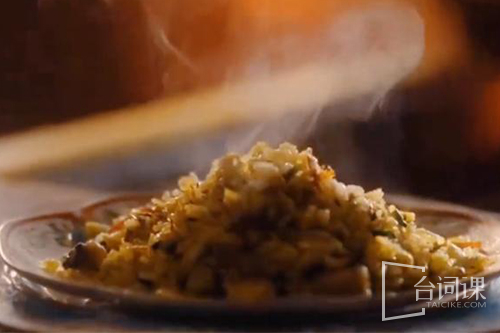The delicacies in 《Blossoms》 include: Spare Ribs Rice Cake, Farewell My Concubine, Ship King Fried Rice, Steamed Rice, Hot Lamb, Rice Rice, Dry Fried Beef River, Sichuan Sand Chicken Feet, Fried Tiao, Dingsheng Cake, Youdunzi, and Crane GodNeedle (pigeon wrapped wings), flame king snake...

Pork Ribs Rice Cake
Spare ribs rice cake is a very famous snack in Shanghai. The ribs in the pork ribs rice cake are not the Shanghai-style fried pork chops that are also famous in Shanghai. Instead, the ribs are wrapped in a layer of paste made with flour, eggs and water, and thenIt is fried in oil instead of deep-fried, so compared with Shanghai-style fried pork chop, it only looks similar in appearance, but it is essentially two different cooking methods.The crispy fried pork ribs, paired with two pieces of soft and glutinous but chewy rice cakes, is the classic snack pork ribs rice cake.Moreover, the dipping sauce that comes with the pork ribs rice cake is not the yellow brand spicy soy sauce that comes standard with fried pork chops, but the store's own salty and sweet sauce.
Farewell My Concubine
Farewell My Concubine is actually turtle stewed in chicken soup, which was a high-end dish at the time.This dish is a famous dish in Huaiyang cuisine. It was originally called "Dragon and Phoenix Stew". According to legend, it was the finale of the "Dragon and Phoenix Feast" prepared by Xiang Yu, the overlord of Western Chu, for Concubine Yu.In fact, it is turtle stewed with old hen.Therefore, it should be said that the name “ Dragon and Phoenix Stew” is more appropriate. Since “Farewell My Concubine” is “Farewell”, why is it still a one-pot stew?“Farewell My Concubine”The soup is clear and fresh and mellow. The soft-shell turtle and chicken meat are tender and crispy, and rich in nutrients. It can be regarded as a high-end dish.Therefore, Mr. Wei spent tens of thousands of dollars to give away 88 copies of “Farewell My Concubine”, which is indeed a generous act.
Ship King Fried Rice
Shipwang Fried Rice is said to be the hometown flavor of Phoenix that Ningbo native Shipwang loves, but it is actually a fabrication. Ningbo people tend to eat noodles in a soupy way and don't like fried rice very much.
Pao rice
Boil the water, pour the overnight cold rice into a bowl, use chopsticks to stir up the rice balls, the soup is watery and steaming.Pair it with various side dishes such as pickled mustard, pickled melon, fermented bean curd, and salted eggs, and you can eat it in one go.
Nowadays, there is no rice bowl in the restaurant. A Bao is a shareholder of Night Tokyo, so the proprietress Lingzi (played by Ma Yili) specially prepares rice bowl for him.But some restaurants have vegetable pickled rice, which was launched to cater to the nostalgic psychology of diners born in the 60s and 70s. Nowadays, what you eat is about feelings. Of course, you won’t care if the price is more expensive. It can also make the store earn a little bit, and now in restaurantsVegetable rice is no longer made with leftovers from the previous night, but has been upgraded to seafood rice, adding clams, razor clams, shrimps, crabs, and even shark fin rice and lobster rice. The taste is naturally very delicious, but it is no longerIt doesn’t feel like it did back then.
Dry Fried Beef River
The so-called “Niuhe” is niuluojiahefen, which is a classic snack in Cantonese cuisine.To be more precise, it is the main dish of Cantonese roadside noodle stalls. Later, it gradually became a signature refreshment in Cantonese restaurants and tea shops.
It is said that in the past, fried rice noodles in Guangdong were wet-fried, that is, thickened.One time, the cornstarch for thickening was used up, and the diners were in a hurry, so the chef had to heat up a red iron wok, stir-fry the rice noodles, and then stir-fry the beef slices with tender oil. Unexpectedly, after it was served to the table, the dinersHe was greatly appreciated, so he fried Niuhe and became an instant hit.Nowadays, the mainstream of Cantonese stir-fried noodles is dry stir-fried, while the original wet stir-fried noodles are rare.









